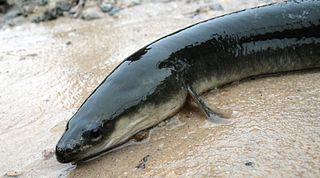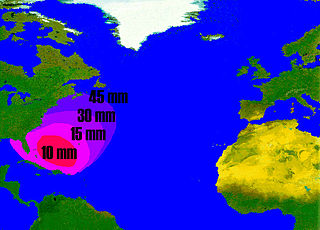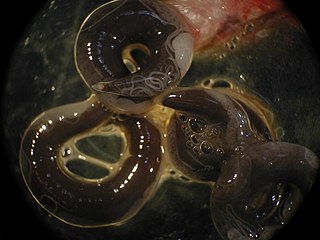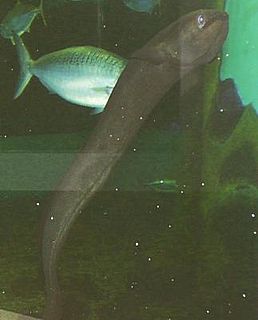
The European eel is a species of eel, a snake-like, catadromous fish. They are normally around 60–80 cm (2.0–2.6 ft) and rarely reach more than 1 m, but can reach a length of up to 1.5 m in exceptional cases.

The American eel is a facultative catadromous fish found on the eastern coast of North America. Freshwater eels are fish belonging to the elopomorph superorder, a group of phylogenetically ancient teleosts. The American eel has a slender, snake-like body that is covered with a mucus layer, which makes the eel appear to be naked and slimy despite the presence of minute scales. A long dorsal fin runs from the middle of the back and is continuous with a similar ventral fin. Pelvic fins are absent, and relatively small pectoral fins can be found near the midline, followed by the head and gill covers. Variations exist in coloration, from olive green, brown shading to greenish-yellow and light gray or white on the belly. Eels from clear water are often lighter than those from dark, tannic acid streams.

The eel is a long, thin bony fish of the order Anguilliformes. Because fishermen never caught anything they recognized as young eels, the life cycle of the eel was a mystery for a very long period of scientific history. Although more than 6500 publications mention eels, much of their life history remains an enigma.
The Anguillidae are a family of ray-finned fish that contains the freshwater eels. Eighteen of the 19 extant species and six subspecies in this family are in the genus Anguilla. They are elongated fish with snake-like bodies, their long dorsal, caudal and anal fins forming a continuous fringe. They are catadromous fish, spending their adult lives in fresh water, but migrating to the ocean to spawn. Eels are an important food fish and some species are now farm-raised, but not bred in captivity. Many populations in the wild are now threatened, and Seafood Watch recommend consumers avoid eating anguillid eels.
The long-finned worm eel or short-headed worm eel, Scolecenchelys breviceps, is a snake eel of the genus Scolecenchelys, found in southern Australia between Rottnest Island and Tasmania, and around New Zealand, to depths of about 50 m, on sandy or muddy bottoms. Its length is between 40 and 60 cm.

The New Zealand longfin eel is a species of freshwater eel that is endemic to New Zealand. It is the largest freshwater eel in New Zealand and the only endemic species – the other eels found in New Zealand are the native shortfin eel, also found in Australia, and the naturally introduced Australian longfin eel. Longfin eels are long-lived, migrating to the Pacific Ocean near Tonga to breed at the end of their lives. They are good climbers as juveniles and so are found in streams and lakes a long way inland. An important traditional food source for Māori, longfin eels are threatened and declining but still commercially fished.

Anguillicoloides crassus is a parasitic nematode worm that lives in the swimbladders of eels and appears to spread easily among eel populations after introduction to a body of water. It is considered to be one of the threats to the sustainability of populations of European eel. It was introduced to the European continent in the 1980s, where it was reported independently from Germany and Italy in 1982, having probably been introduced from Taiwan. It is thought to have reached England in 1987 from continental Europe. It is a natural parasite of the Japanese eel in its native range.

The speckled longfin eel, Australian long-finned eel or marbled eel is one of 15 species of eel in the family Anguillidae. It has a long snake-like cylindrical body with its dorsal, tail and anal fins joined to form one long fin. It usually has a brownish green or olive green back and sides with small darker spots or blotches all over its body. Its underside is paler. It has a small gill opening on each side of its wide head, with thick lips. It is Australia's largest freshwater eel, and the female usually grows much larger than the male. It is also known as the spotted eel.

Anguilla bicolor is a species of eel in the genus Anguilla of the family Anguillidae, consisting of two subspecies.

The mottled eel, also known as the African mottled eel, the Indian longfin eel, the Indian mottled eel, the long-finned eel or the river eel, is a demersal, catadromous eel in the family Anguillidae. It was described by John McClelland in 1844. It is a tropical, freshwater eel which is known from East Africa, Bangladesh, Andaman Islands, Mozambique, Malawi, Sri Lanka, Sumatra, and Indonesia and recently from Madagascar. The eels spend most of their lives in freshwater at a depth range of 3–10 metres, but migrate to the Indian Ocean to breed. Males can reach a maximum total length of 121 centimetres and a maximum weight of 7,000 grams. The eels feed primarily off of benthic crustaceans, mollusks, finfish and worms.

The Japanese eel is a species of anguillid eel found in Japan, Korea, China, and Vietnam, as well as the northern Philippines. Like all the eels of the genus Anguilla and the family Anguillidae, it is catadromous, meaning it spawns in the sea, but lives parts of its life in fresh water. The spawning area of this species is in the North Equatorial Current in the western North Pacific to the west of the Mariana Islands. The larvae are called leptocephali and are carried westward by the North Equatorial Current and then northward by the Kuroshio Current to East Asia, where they live in rivers, lakes, and estuaries. The Japanese eel is an important food fish in East Asia, where it is raised in aquaculture ponds in most countries in the region. In Japan, where they are called unagi, they are an important part of the food culture, with many restaurants serving grilled eel, which is called kabayaki.

The giant mottled eel, also known as the marbled eel, is a species of tropical anguillid eel that is found in the Indo-Pacific and adjacent freshwater habitats.

Eels are ray-finned fish belonging to the order Anguilliformes, which consists of eight suborders, 19 families, 111 genera, and about 800 species. Eels undergo considerable development from the early larval stage to the eventual adult stage, and most are predators.

Ophichthus is a genus of eels in the snake eel family Ophichthidae.

Scolecenchelys is a genus of eels in the snake eel family Ophichthidae.
The Highlands long-finned eel is an eel in the family Anguillidae. It was described by Gilbert Percy Whitley in 1938. It is a tropical eel known from freshwaters in eastern New Guinea. The eels spend most of their lives in freshwater but migrate to the ocean to breed. Males can reach a maximum total length of 80 centimetres.
The Polynesian longfinned eel, also known as the Pacific long-finned eel, is an eel in the family Anguillidae. It was described by Johann Jakob Kaup in 1856. It is a tropical eel found in freshwaters in the Pacific, including Sulawesi, Indonesia; the Society Islands, and Pitcairn. The eels spend most of their lives in freshwater, but migrate to the ocean to breed. Males can reach a maximum total length of 100 centimetres, while females can reach a maximum TL of 165 centimetres and a maximum weight of 9,000 grams.

The African longfin eel, also known simply as the longfin eel, is an eel in the family Anguillidae. It was described by Wilhelm Peters in 1852, originally under the genus Muraena. It is a tropical eel known from freshwaters in southern Kenya, Cape Agulhas, Madagascar, and New Caledonia. The eels spend most of their lives in freshwaters far inland, but migrate to the Western Indian Ocean to breed. Males can reach a maximum total length of 150 centimetres; females can reach a maximum standard length of 120 centimetres and a maximum weight of 5,000 grams. The eels can live for about 20 years. Juveniles and adults are known to feed off of carcasses, crabs, and bony fish.
The Pacific shortfinned eel, also known as the Pacific shortfinned freshwater eel, the short-finned eel, and the South Pacific eel, is an eel in the family Anguillidae. It was described by Albert Günther in 1871. It is a tropical, freshwater eel which is known from western New Guinea, Queensland, Australia, the Society Islands, and possibly South Africa. The eels spend most of their lives in freshwater, but migrate to the Pacific Ocean to breed. Males can reach a maximum total length of 110 centimetres, but more commonly reach a TL of around 60 cm. The Pacific shortfinned eel is most similar to Anguilla australis, and Anguilla bicolor, but can be distinguished by the number of vertebrae.

Juvenile fish go through various stages between birth and adulthood. They start as eggs which hatch into larvae. The larvae are not able to feed themselves, and carry a yolk-sac which provides their nutrition. Before the yolk-sac completely disappears, the tiny fish must become capable of feeding themselves. When they have developed to the point where they are capable of feeding themselves, the fish are called fry. When, in addition, they have developed scales and working fins, the transition to a juvenile fish is complete and it is called a fingerling. Fingerlings are typically about the size of fingers. The juvenile stage lasts until the fish is fully grown, sexually mature and interacting with other adult fish.














